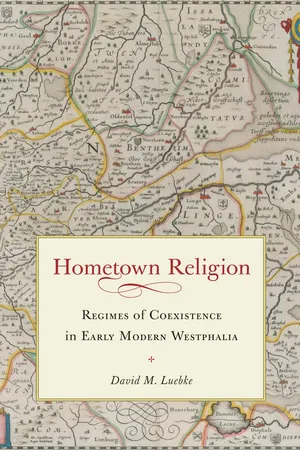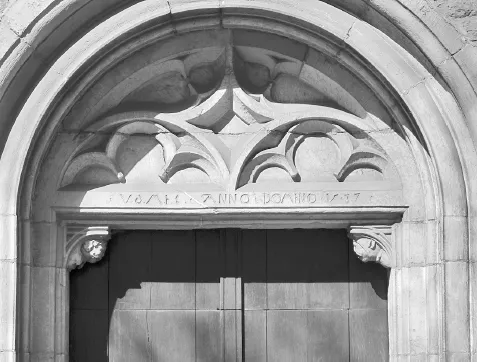![]()
Order and Belief
THE NASCENCE OF A BICONFESSIONAL REGIME
There is a curious inscription on the south portal of the collegiate church of St. Ludgerus in Münster, chiseled into the lintel just above the entryway: “V.D.M.I.E. ANNO DOMINI 1537” (see figure 2).1 A modern churchgoer would recognize the Latin phrase “Year of Our Lord.” But the letters would probably mystify most passersby. What could they mean? Might they refer to some donor from long ago?
In 1537, the inscription would have mystified no one. The initials refer to a phrase in 1 Peter 1:25: Verbum Domini manet in eternum (The word of the Lord endures forever). Everyone would have recognized their significance. These “words about God’s word,” as Joseph Koerner points out, “were the earliest motto of Protestantism,” a clear sign of support for Martin Luther and identification with his reforms.2 In one of its earliest political uses, Elector John the Constant of Saxony festooned his lodgings in Speyer for the Imperial Diet of 1526 with arms bearing the V.D.M.I.E. motto.3 Again in 1530, the mighty Landgrave Philipp of Hessen and his entourage had worn these letters on their sleeves during the festive entry of Emperor Charles V into the city of Augsburg to the Imperial Diet of that year. The action signified that Philipp’s participation in these solemnities implied no softening of his stance in the matter of religious reform.4 Not long after, the same slogan was adopted by the Protestant League of Schmalkalden (also known as the Schmalkaldic League)—the first defensive pact among reform-minded princes and city-states in the empire.5 By the time these initials were carved into Ludgerus’s south portal, the motto had been adopted by reforming princes throughout northern Germany6
Fig. 2. Inscription on the south portal of St. Ludgerus church in Münster, “V.D.M.I.E. ANNO DOMINI 1537.” Note that the word “DOMINI” was first misspelled “DOMINO” and then rather awkwardly corrected. (Photograph courtesy of Werner Freitag)
Through the centuries, the portal’s inscription has borne silent testimony to the presence of a Protestant community within the parish of St. Ludgerus. The full impact of that testimony emerges from its date: 1537. In June 1535, barely two years before the inscription was made, the revolutionary Anabaptist Kingdom of Münster had gone down in bloody defeat. In its aftermath, Anabaptist leaders had been tortured, tried, and executed; the property of re-baptized citizens was seized. As spectacular as they were, however, these events did not inaugurate an era of conformity in belief and religious practice. Catholicism was reestablished as the sole, institutional form of Christian religion in the prince-bishopric. But almost immediately after the conquest of 1535, Lutheran citizens who had fled the Anabaptist regime began returning to the capital, along with Catholics who had done the same.7 By July, Anabaptist women who had slipped out of town during the siege were “returning in droves.”8 New families, many of them Protestant, filtered in, as well.9 Once the Anabaptists had been converted or driven out, there were no further persecutions on religious dissenters until the very end of the century.10 On the contrary, Protestants gradually resumed their positions in Westphalian society and political life, even serving as lay officers in the administration of the Roman Catholic church.11 Even in the capital, a few Lutheran clergy held on to their posts, at least for a while. One such figure was Rudolf Köster, a chaplain at St. Ludgerus, who according to the contemporary Lutheran chronicler Hermann Hamelmann distributed the communion in both kinds to the congregation’s Protestant members during the 1540s and 1550s.12
The eventual outcome of these seemingly contradictory developments was a complex religious regime in which Catholics, Lutherans, and, somewhat later, Calvinists managed to inhabit parishes that remained within the institutional framework of the Roman church—its system of benefices, prebends, and rights of patronage. Often this involved the sharing of sacred spaces, which could take the form of liturgical accommodations or the division of sacred time and space within the parish. In a few instances, moreover, parishes went over to Lutheran or Calvinist observance entirely, though without causing a formal, institutional break with the established church. This delicate arrangement would survive, in one form or another, into the seventeenth century, three generations and more after the “Anabaptist madness.”
How did this system take shape? What were the social, cultural, and historical ligaments that held it together? Until the 1990s, historians had few answers to such questions, either because their own religious commitments blinded them to the possibility of confessional coexistence or because their focus on the emergence of aggressively intolerant religious cultures in the sixteenth and seventeenth centuries prompted them to dismiss pluri-confessional regimes as inconsequential distractions from their grand narrative of state power and its consolidation.13 It also obscured the enormous variation in confessional relations from one region of the empire to another. Unlike in the mostly Catholic south and the predominantly Lutheran northeast, no confession dominated in the empire’s northwestern quadrant. In this “no man’s land,” argues Anton Schindling, a prince or city council could remain neutral or pursue moderate reforms long after the politics of militancy and confrontation had ruled out such options elsewhere.14 Where the balance of power favored landed aristocracy, moreover, the material self-interest of nobles in controlling the distribution of ecclesiastical prebends gave them a stake in perpetuating the Roman church as an institutional structure, irrespective of their own religious commitments. If institutional conservatism such as this did not preclude the exercise of Protestant religion, so much the better.
These arguments explain a great deal about the curious longevity of religious coexistence in the prince-bishopric of Münster. In part it reflected ambiguity at the top: the religious commitments of Franz von Waldeck—the prince-bishop who oversaw the Anabaptists’ destruction—were anything but firmly Catholic. For a variety of reasons, practical as well as theological, he and his immediate successors in office proved reluctant to enforce Catholic orthodoxy against dissenters who were willing to accept their authority as secular overlords in the territory. By the same token, despite its increasingly Protestant religious inclinations, the powerful Westphalian nobility was motivated by considerations of power, wealth, and prestige to conserve the existing church structure and keep it within the Roman hierarchy of obedience. As a result, by the 1560s the prince-bishopric had become a biconfessional polity in everything but name, even though no formal change in its confessional status had taken place. This equilibrium remained in place until a more militant, Tridentine Catholicism came to the fore.
That, too, is the subject of a later chapter. The argument here is that there was more to religious coexistence in the prince-bishopric of Münster than material self-interest, theological confusion, or the sheer inability of any party to impose its will on the rest. For one thing, Münster’s regime of confessional coexistence was reinforced by the comprehensive religious settlement achieved at the Imperial Diet of Augsburg in 1555—in particular, the clauses that governed confessional relations inside the empire’s many ecclesiastical principalities. Not surprisingly, Protestants in the Westphalian towns interpreted these provisions to bestow on them the freedom to practice the Augsburg Confession. But they were not alone in this: until the late 1580s, the prince-bishopric’s governing councils also acted on the assumption that there were two lawful religions, the faiths of Rome and Augsburg, within the prince-bishopric.
These assumptions crystallized in language around certain key terms for beliefs and practices that were not included among the lawful religions—especially the words for heresy (Ketzerei) and heretic (Ketzer). In most cases, these terms were used to describe not “non-Catholics” but a much more specific category—Wedderdoeper (re-baptizers), or those who, in the perception of Catholics and mainstream Protestants, were spiritual descendants of the Melchiorite Anabaptists whose apocalyptic rule over the city of Münster was the occasion for some of the most spectacular mayhem in a century full of religious violence. The use of negative definitions was rife with potential for linguistic confusion. It did not distinguish, for example, between apocalyptic Anabaptists and the quietist followers of Menno Simons, of whom there were a growing number resident in the prince-bishopric. Nor could it easily accommodate a new form of Protestant belief and practice that made its first appearance in the diocese during the 1560s: Calvinism. Even so, the language of negative definitions nourished complicity between the adherents of Rome and Augsburg, uniting them against a common enemy that was thought to pose an existential threat. Thus, the traumatic Anabaptist episode had the paradoxical effect of promoting, within the existing institutional framework of spiritual authority, a latitudinarian approach to differences of belief and practice among the mainstream Christian denominations.
CONFESSIONAL AMBIGUITIES, BICONFESSIONAL EXPERIMENTS
In the annals of sixteenth-century religious warfare, the siege of Münster in 1534–35 surely ranks among the most gruesome.15 On the night of 24–25 June 1535, troops of Prince-Bishop Franz von Waldeck breached the ramparts and advanced into the heart of the city, taking its defenders by surprise. By the end of the day, the last remnant had been overwhelmed on the main marketplace (Prinzipalmarkt), where they had thrown up one final, makeshift blockade.16 Among the last to fall were four sentries who had barricaded themselves in the tower of the St. Lambertus parish church, at the northern end of the marketplace; three of them were run through, and the fourth jumped to his death on the street below.17 Thereafter, according to an eyewitness who had defected to the besieging army, “The mercenaries went into all the houses through the entire city, searching for Anabaptists . . . high and low,” plundering as they went, “and when they found Anabaptists they pulled them out of the houses and killed them dead in the street.”18 The Catholic chronicler Hermann von Kerssenbrock wrote, “Every day for about eight days, bloody spectacles like this were performed against those who were forced out of their hiding places.”19 It is impossible to say with any precision how many died in the fighting and the slaughter that followed. Assuming that all of the armed defenders were killed in the final onslaught, then the death toll was between 1,600 and 2,000, plus an unknown number of unarmed Anabaptist men and women.20 A few orphaned children, according to Kerssenbrock, were given “as gifts to high-ranking men and women as if they were chattel.”21 Among the captives was Jan Beukelszoon van Leiden, the apocalyptic king of the “New Jerusalem,” who was found hiding in a cellar. On 22 January 1536, he and two adjutants, former Mayor Bernhard Knipperdolling and Bernhard Krechting, an erstwhile priest, were tortured with “glowing tongs” and finally dispatched with a dagger stab “into the chest of each man.”22
The Anabaptists of Münster, or many of them, had been willing to die for religion. But we must not assume the reverse—that the victors killed for religion’s sake, in defense of the one and only true faith. On the contrary, the Anabaptists were crushed by a broad coalition whose financial backers and active combatants included proponents of evangelical reform, defenders of the old church, and fence sitters in the ongoing religious controversy. If anything bound them together theologically, it was their common, uncompromising hostility toward the Anabaptist creeds, which the Imperial Diet had condemned as heresy in 1529.23
Prince Bishop Franz von Waldeck, for his part, was certainly no staunch antagonist to Luther and his followers. On the contrary, the surviving evidence of his religious inclinations describes a prelate who favored evangelical reforms.24 One likely motivation for these sympathies combined marital desires with dynastic ambitions. Franz was eager to legitimate his union with Anna Polmann, a commoner who had been his de facto spouse since 1523 and with whom he eventually sired no fewer than eight children.25 Famously, Luther and his followers condemned vows of clerical celibacy and emboldened c...


